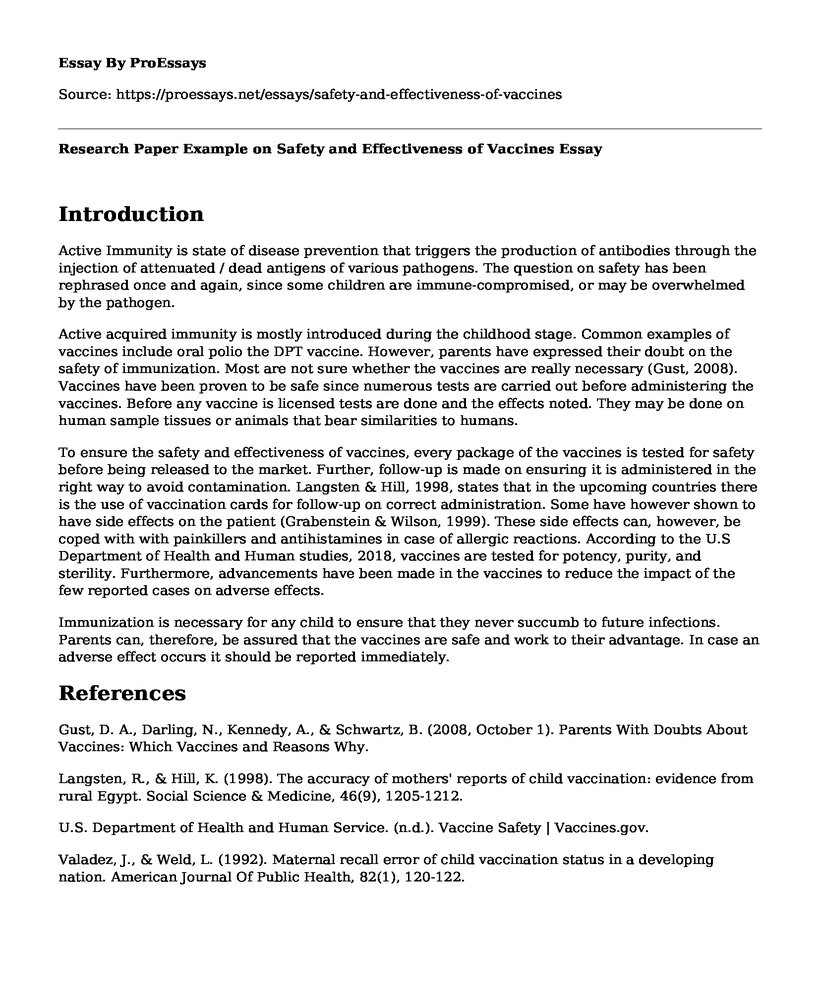Introduction
Active Immunity is state of disease prevention that triggers the production of antibodies through the injection of attenuated / dead antigens of various pathogens. The question on safety has been rephrased once and again, since some children are immune-compromised, or may be overwhelmed by the pathogen.
Active acquired immunity is mostly introduced during the childhood stage. Common examples of vaccines include oral polio the DPT vaccine. However, parents have expressed their doubt on the safety of immunization. Most are not sure whether the vaccines are really necessary (Gust, 2008). Vaccines have been proven to be safe since numerous tests are carried out before administering the vaccines. Before any vaccine is licensed tests are done and the effects noted. They may be done on human sample tissues or animals that bear similarities to humans.
To ensure the safety and effectiveness of vaccines, every package of the vaccines is tested for safety before being released to the market. Further, follow-up is made on ensuring it is administered in the right way to avoid contamination. Langsten & Hill, 1998, states that in the upcoming countries there is the use of vaccination cards for follow-up on correct administration. Some have however shown to have side effects on the patient (Grabenstein & Wilson, 1999). These side effects can, however, be coped with with painkillers and antihistamines in case of allergic reactions. According to the U.S Department of Health and Human studies, 2018, vaccines are tested for potency, purity, and sterility. Furthermore, advancements have been made in the vaccines to reduce the impact of the few reported cases on adverse effects.
Immunization is necessary for any child to ensure that they never succumb to future infections. Parents can, therefore, be assured that the vaccines are safe and work to their advantage. In case an adverse effect occurs it should be reported immediately.
References
Gust, D. A., Darling, N., Kennedy, A., & Schwartz, B. (2008, October 1). Parents With Doubts About Vaccines: Which Vaccines and Reasons Why.
Langsten, R., & Hill, K. (1998). The accuracy of mothers' reports of child vaccination: evidence from rural Egypt. Social Science & Medicine, 46(9), 1205-1212.
U.S. Department of Health and Human Service. (n.d.). Vaccine Safety | Vaccines.gov.
Valadez, J., & Weld, L. (1992). Maternal recall error of child vaccination status in a developing nation. American Journal Of Public Health, 82(1), 120-122.
Cite this page
Research Paper Example on Safety and Effectiveness of Vaccines. (2022, Feb 11). Retrieved from https://proessays.net/essays/safety-and-effectiveness-of-vaccines
If you are the original author of this essay and no longer wish to have it published on the ProEssays website, please click below to request its removal:
- Improving the Patient Emergency Department Prior to the Launch of ED-CAHPS
- Contemporary Ethical Issues: Physician-Assisted Suicide Essay
- The Progressive Era: Emerging Concepts of Social Work and Social Welfare From 1900 to 1930
- Essay Sample on The Functional Movement Screen in Medicine
- Clinical and Organizational Problem in Memorial Hospital, Jacksonville Paper Example
- Essay Sample on Providing Healthcare Services for All Without Discrimination
- The History of Nursing in Canada: From WW1 to Today - Essay Sample







